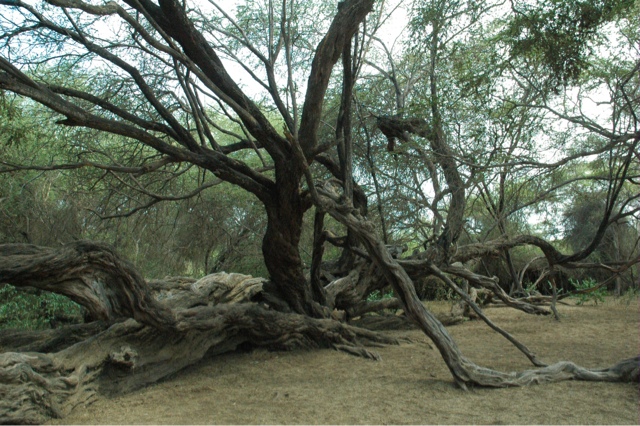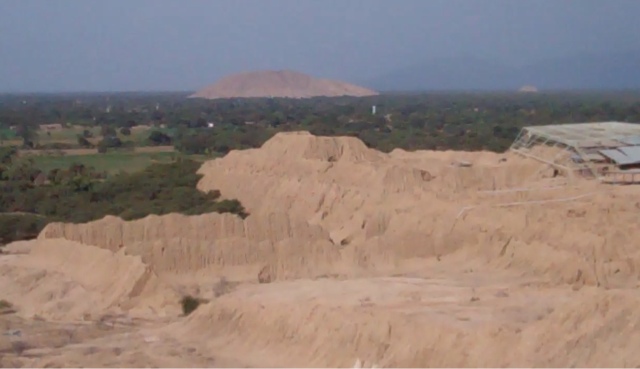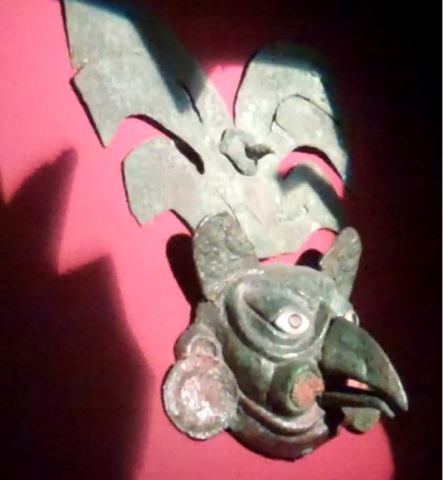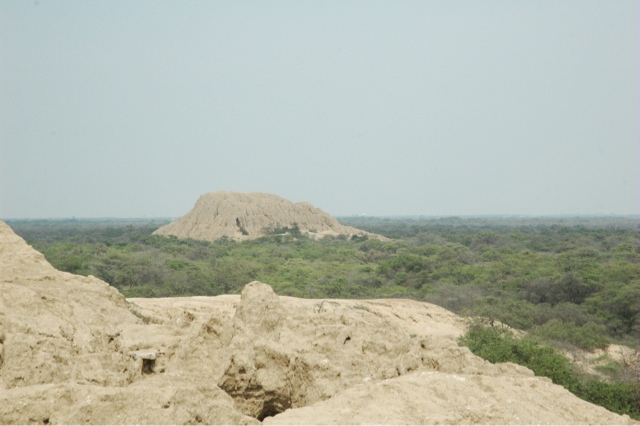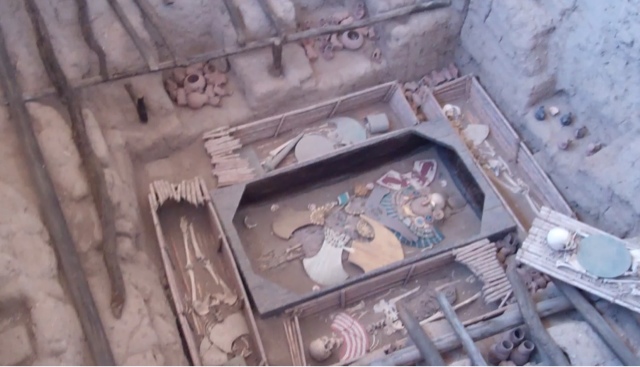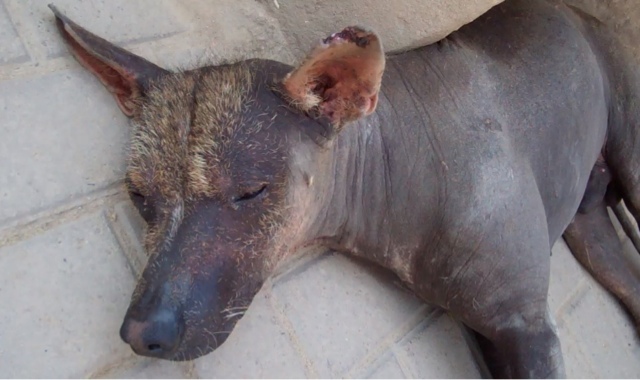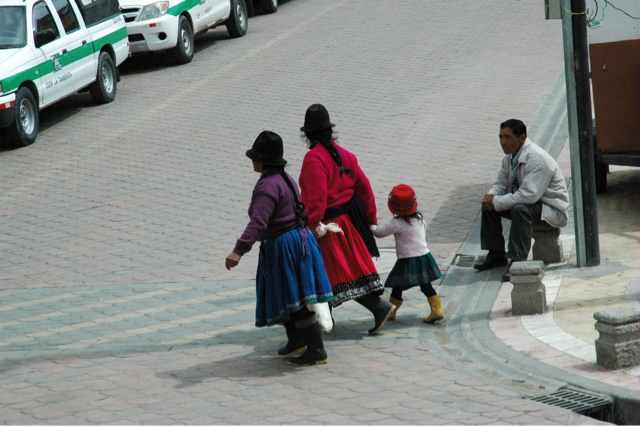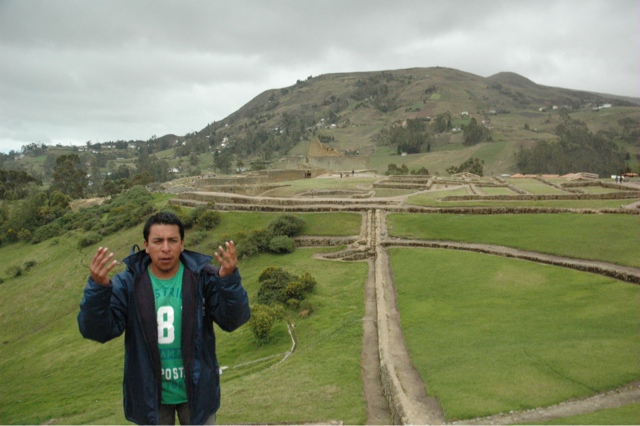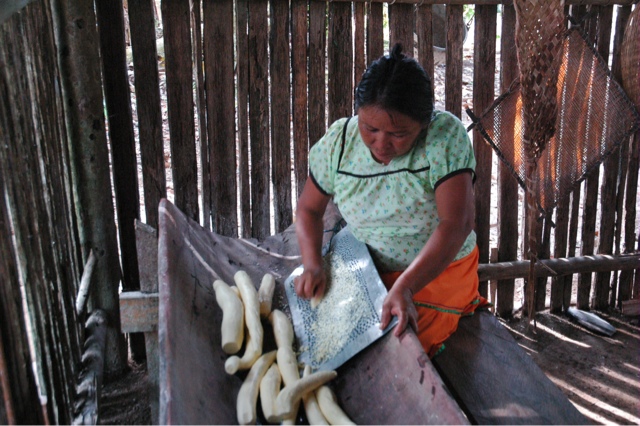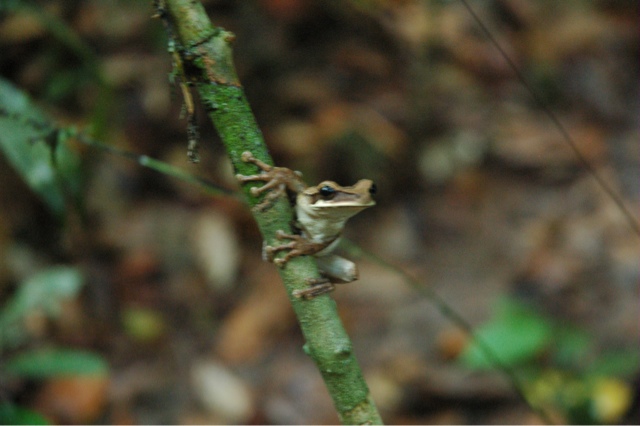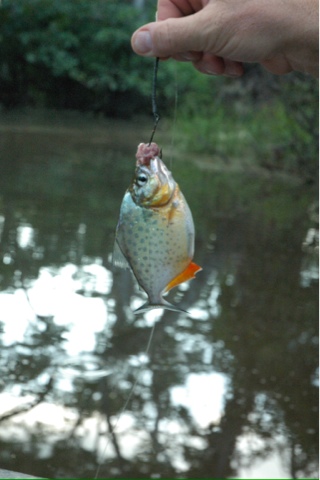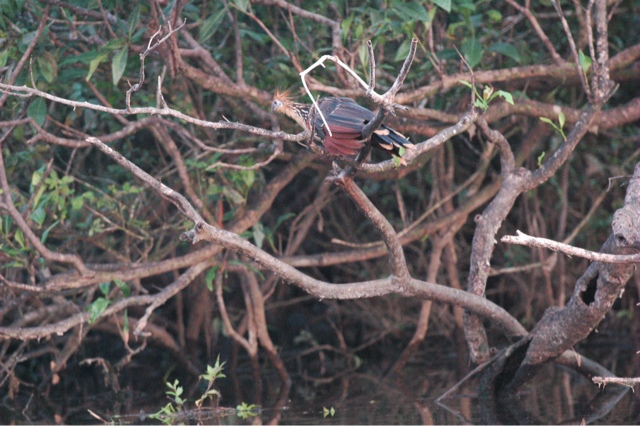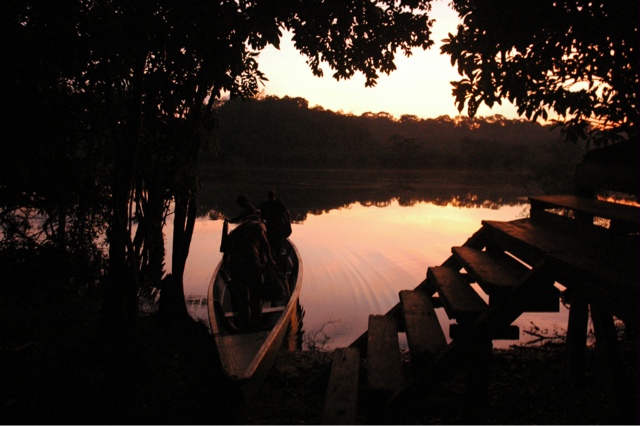We've spent the last couple of days in Chiclayo, Peru. This area has a lot of similarities to Egypt and is a region rich in archeological sites. The Lambayeque and Moche civilizations predates the Incas. They, similar to the Egyptians, buried their leaders, warriors and priests together with jewellery, artifacts, sacrificial animals, wives and guardians. Archeologists are still uncovering new sites.
We started with a visit to the pyramids themselves. The pyramids here are made with thousands of adobe bricks (adobe bricks are made with mud, clay and straw). The pyramids reach 141 feet high and in the Lambayeque valley, you find 26 major pyramids built from AD 1000. After a rash of looting, the government brought in archeologists to start excavating the sites. They are all now well-protected and the government was successful in recovering some important pieces that had been smuggled out of the country.
They have also constructed a fabulous museum in 2002 to display the treasures from Lord Sipan's tomb which was discovered in 1987. It was fascinating to see the gold and silver jewellery, copper items, necklaces made from millions of small beads carved from shells, gold banners and hundreds of clay pots in pristine condition.
The pictures below are only a small part of Lord Sipan's tomb but his actual tomb with the gold, silver and cooper artifacts are in the new museum where they didn't allow any photographs to be taken.
We have been in a rain forest, a cloud forest, a temperate alpine forest and now we have been in an equatorial dry forest. This area gets very little rain, but the view from above shows it to be a lush green forest. On the ground, the earth is dry and dusty. These trees survive because of their deep roots (as deep as 35 meters). Tucked into the forest are several other adobe pyramids where excavation work is still going on. Unfortunately the accompanying museum was closed today, but they say there was more than a ton of gold found in one of the tombs.
We have been really surprised and fascinated with the sites we have visited and intrigued to see pyramids in this part of the world. We knew so little about Peru before arriving here. And we saw a Peruvian Hairless dog. Too cute for words. You tell me if you agree.
Monday, December 31, 2012
Saturday, December 29, 2012
Transportation in South America
We have been using public buses to get around during our land travels in South America. It has been an interesting experience so far. Yes, I know. Jens is still a little in shock when I suggest taking a local bus instead of a taxi. It just sometimes makes more sense, particularly in the city of Quito where they have designated bus lanes which means they move quicker than anything else on the road. And at $0.25 for a ride, it is even harder to resist.
It is the single best way to get around, without a doubt. The cost of travel is low and the frequency of buses is high. A very good combination. The buses advertise air conditioning (we've only experienced it once), movies (always in Spanish of course), and toilets (but you have to ask the driver's assistant for the key). Oh yes, there is a driver and an assistant. The assistant leans out of the bus calling for other passengers as we travel down the road, collects the money, helps people with their luggage and so on, so that the driver can concentrate on driving. Not a bad plan. Particularly on the steep and narrow roads where they like to overtake slower moving vehicles on hairpin turns. Oh yes, I should also mention that bus travel is not for the faint of heart.
In Ecuador, the cost of intercity buses runs about $1.00 per hour of travel. They usually leave the terminal on time, but they will stop to pick up passengers on the way. They also stop along the way to pick up sellers of food, cd's, chocolates, drinks, fruit, etc. Food is usually a tray of home cooked (or side of the road cooked) chicken, frittata, potatoes, rice, and so on. So you never go hungry or thirsty. But with the long trips and infrequent stops, it's best not to consume too much.
The only danger of riding the buses is theft. We have heard numerous stories of travelers who have had their bags stolen, their backpacks slit open with a knife and their computers and cameras stolen. We have taken to traveling with our bags with all our valuables on our laps. Our backpacks with our clothes go in the compartment under the bus. So far, this strategy has worked.
We haven't actually traveled on a bus where the locals bring their chickens and such on board, but today I did see a man take two bags out of the luggage compartment and on closer inspection you see that he is transporting turkeys and geese. I guess he didn't pay for a coach class ticket for them.
It is the single best way to get around, without a doubt. The cost of travel is low and the frequency of buses is high. A very good combination. The buses advertise air conditioning (we've only experienced it once), movies (always in Spanish of course), and toilets (but you have to ask the driver's assistant for the key). Oh yes, there is a driver and an assistant. The assistant leans out of the bus calling for other passengers as we travel down the road, collects the money, helps people with their luggage and so on, so that the driver can concentrate on driving. Not a bad plan. Particularly on the steep and narrow roads where they like to overtake slower moving vehicles on hairpin turns. Oh yes, I should also mention that bus travel is not for the faint of heart.
In Ecuador, the cost of intercity buses runs about $1.00 per hour of travel. They usually leave the terminal on time, but they will stop to pick up passengers on the way. They also stop along the way to pick up sellers of food, cd's, chocolates, drinks, fruit, etc. Food is usually a tray of home cooked (or side of the road cooked) chicken, frittata, potatoes, rice, and so on. So you never go hungry or thirsty. But with the long trips and infrequent stops, it's best not to consume too much.
The only danger of riding the buses is theft. We have heard numerous stories of travelers who have had their bags stolen, their backpacks slit open with a knife and their computers and cameras stolen. We have taken to traveling with our bags with all our valuables on our laps. Our backpacks with our clothes go in the compartment under the bus. So far, this strategy has worked.
We haven't actually traveled on a bus where the locals bring their chickens and such on board, but today I did see a man take two bags out of the luggage compartment and on closer inspection you see that he is transporting turkeys and geese. I guess he didn't pay for a coach class ticket for them.
Piura ...a small town in Peru
We travelled by bus today from Cuenca, Ecuador to Piura, Peru. I really didn't want to another another overnight bus trip, arriving to our destination in the wee hours of the morning with feeling grumpy and tired. We found a day time option, which has turned out to be quite ok, despite the early departure of 7:15 AM and the sometimes leaps of faith in transferring buses and border crossings. We have read quite a few stories of other peoples adventures in taking a bus across the border to Peru, most of them a little on the scary side. However, I think some things have improved over the past year or two and we seemed to manage it quite fine.
The trip started at the bus station in Cuenca. We were out of the hostel early and couldn't find a taxi, so we jumped on the first bus and for 0.50 we were at the bus station in 10 minutes. Now to buy some breakfast. A couple of stale donuts and a sandwich for Jens and we were set to go. We picked up people along the way and were finally out of the city and into the highlands with beautiful pastures and vistas as far as the eye could see. We made our way down towards the coast where we passed miles and miles of banana plantations.
We reached the border town of Huaqullas around noon and although we knew we had to switch buses we thought it would be after we cleared out of Ecuador. So leap of faith, we jump into the bus we were told was going to Piura and sure enough, we get to the border office where we officially stamp out of Ecuador and clear into Peru.
A VERY DIFFERENT LANDSCAPE
The scene around us has changed dramatically. We are now on the coast where there is very little rain. It is reminiscent of the terrain in the Fujairah area of the UAE with dry rocky mountains on the one side and the sea on the other. We decided to continue our journey as far down as Piura, which is as far as this particular bus goes. There are other towns along the coast as the surf here is said to be excellent and has resulted in some laid back beach resorts and surfer hang-outs. This is not really our scene. Our destination is Chiclayo where there are some interesting sites and ruins. Yup, hate to admit it. We're not in our 20's anymore.
We arrived around 7PM to find Piura to be a very dusty city. But, we found a very modern shopping mall and we had our first Starbuck's coffee (yes, you read that correctly, a Starbuck's coffee!!) in about three or four months! What a nice treat after being on buses for 12+ hours.
BACK TO CUENCA
I haven't yet told you about our excursion in Cuenca. The reason for the trip there was to visit the Inca ruins which are about two hours outside of Cuenca. As well, Cuenca is a well preserved Colonial town and is a UNESCO World Heritage site. It really is a lovely town and it is easy to see why so many expats are making this their home away from home.
It was a nice visit to the Ingapirca site where we saw the eliptical shaped temple of the sun, and the area where the tombs of the high priests had been excavated not so long ago, all explained to us by a local Canari guide with a lot of expression and enthusiasm. This is the largest Inca site in Ecuador and was said to be the second capital of the Inca empire. Overall, a good precursor to our trip to Machu Pichu.
The trip started at the bus station in Cuenca. We were out of the hostel early and couldn't find a taxi, so we jumped on the first bus and for 0.50 we were at the bus station in 10 minutes. Now to buy some breakfast. A couple of stale donuts and a sandwich for Jens and we were set to go. We picked up people along the way and were finally out of the city and into the highlands with beautiful pastures and vistas as far as the eye could see. We made our way down towards the coast where we passed miles and miles of banana plantations.
We reached the border town of Huaqullas around noon and although we knew we had to switch buses we thought it would be after we cleared out of Ecuador. So leap of faith, we jump into the bus we were told was going to Piura and sure enough, we get to the border office where we officially stamp out of Ecuador and clear into Peru.
A VERY DIFFERENT LANDSCAPE
The scene around us has changed dramatically. We are now on the coast where there is very little rain. It is reminiscent of the terrain in the Fujairah area of the UAE with dry rocky mountains on the one side and the sea on the other. We decided to continue our journey as far down as Piura, which is as far as this particular bus goes. There are other towns along the coast as the surf here is said to be excellent and has resulted in some laid back beach resorts and surfer hang-outs. This is not really our scene. Our destination is Chiclayo where there are some interesting sites and ruins. Yup, hate to admit it. We're not in our 20's anymore.
We arrived around 7PM to find Piura to be a very dusty city. But, we found a very modern shopping mall and we had our first Starbuck's coffee (yes, you read that correctly, a Starbuck's coffee!!) in about three or four months! What a nice treat after being on buses for 12+ hours.
BACK TO CUENCA
I haven't yet told you about our excursion in Cuenca. The reason for the trip there was to visit the Inca ruins which are about two hours outside of Cuenca. As well, Cuenca is a well preserved Colonial town and is a UNESCO World Heritage site. It really is a lovely town and it is easy to see why so many expats are making this their home away from home.
It was a nice visit to the Ingapirca site where we saw the eliptical shaped temple of the sun, and the area where the tombs of the high priests had been excavated not so long ago, all explained to us by a local Canari guide with a lot of expression and enthusiasm. This is the largest Inca site in Ecuador and was said to be the second capital of the Inca empire. Overall, a good precursor to our trip to Machu Pichu.
Monday, December 24, 2012
Quito's Churches
Ecuador is primarily a Catholic society and has it's share of large, extravagant cathedrals and churches, especially in the capital cities. Quito has several remarkable churches. The Compania de Jesus is the city's most ornate and is said to have been decorated with more than 7 tons of gold (sounds like a lot and I haven't been able to find a verification of this). Built by the Jesuits in 1605 it took 160 years to complete.
We visited a few churches, but the most memorable was the Basilica del Voto Nacional. Memorable because you can see this church from almost any point in Quito and for an entry fee of $4.00 per person, you can climb and explore almost every corner of the church.
Traveling around the world, we realize that safety standards are quite different. In some countries I don't think the word safety is even in their vocabulary. But, it does allow us to do a lot and probably see a lot more. This church is one example. The areas that we explored would have been blocked to tourists in most other countries.
We visited a few churches, but the most memorable was the Basilica del Voto Nacional. Memorable because you can see this church from almost any point in Quito and for an entry fee of $4.00 per person, you can climb and explore almost every corner of the church.
| Walking over the top of the cathedral. Notice the safety ropes! Yes, safety is important. |
 |
| A view from the clock tower. |
 |
| View from the steeple. In the far distance you see the statue of the Virgin Mary with wings. |
 |
| The last set of stairs up to the steeple viewing platform. |
Traveling around the world, we realize that safety standards are quite different. In some countries I don't think the word safety is even in their vocabulary. But, it does allow us to do a lot and probably see a lot more. This church is one example. The areas that we explored would have been blocked to tourists in most other countries.
Friday, December 21, 2012
Waterfalls, Thermal Baths, Local Markets, Volcanic Crater Lakes
Ecuador is a rich and diverse country. Every day provides a new and interesting experience. A few things that have stuck with me are the landscape and the people. The country gives you lush green hillsides to steep rugged and jagged mountains, snow-capped volcanoes and treacherously steep cliffed drops, to lovely alpine meadows, to rolling farmland that looks like a patchwork of miles and miles of crops. Then you have the Amazon, which is a world unto itself. And on the other side of the Andes you have the flat lands down to the coast where the banana and cocoa plantations are aplenty.
The people are friendly, quiet and kind. The traditional clothes and lifestyle are still common in the rural areas. Each community has a slightly different style of dress, but what they all have in common is their stature. They are a small people, most barely reaching up to my armpits. Both the men and the women wear their hair long - men often in braids down their back, women with a long tail wrapped with a piece of colorfully woven cloth. The women carry their children on their backs well past the age where they can walk on their own. But, I have to say, the children are well-behaved and seem to be quite content even though their view is mostly of the back of their mother's head.
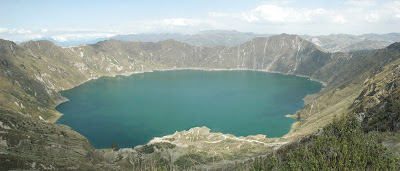 |
| The crater lake in Quilotoa - the water is alkaline and the lake is said to be bottomless. |
 |
| San Rafael Falls in Reventador |
| Another crater lake, Las Orquideas, this time with two islands in the middle. It was a lovely trek around the rim. |
| The thermal baths at Papallacta - hot water, straight from the ground! |
| Another impressive view. |
The people are friendly, quiet and kind. The traditional clothes and lifestyle are still common in the rural areas. Each community has a slightly different style of dress, but what they all have in common is their stature. They are a small people, most barely reaching up to my armpits. Both the men and the women wear their hair long - men often in braids down their back, women with a long tail wrapped with a piece of colorfully woven cloth. The women carry their children on their backs well past the age where they can walk on their own. But, I have to say, the children are well-behaved and seem to be quite content even though their view is mostly of the back of their mother's head.
| Buying Guinea Pigs at the local market - first they are carefully checked for size and weight before being unceremoniously dropped into a sack. |
| A healthy bunch of guinea pigs for sale. |
| Piglets on a string, ready to be sold. But bring your own string if you want to buy one. |
| A local lady and her daughter selling their wares. |
| The ladies in this region wear cloth wrapped on their head while the men wear felt hats. In the South the women wear the felt hats. |
| A busy day at the animal market. |
| The Poncho Market - this one is a little more geared to the tourists. |
| Lots of handicrafts and things for sale. Caution - even here some things are actually "made in China"! |
Thursday, December 20, 2012
Back to SY SEGWUN for the Holidays
We arrived back to the boat last night after a long day of bus travel from Quito. She was waiting patiently for us at the marina as we have been out exploring Ecuador since November 26th. If you don't count for the layer of dust on the topside and the growth of the green algae underneath, she is quite fit and everything looks in good order.
It has been over a week since my last posting. A couple of reasons for this. Firstly, I came down with a stomach bug and between fevers, headaches and running to the toilet, I was really not in a mood to do any writing. After a quick stop at the hospital in Quito to get my fluids topped up, I am back on the mend and feeling quite good.
Also, I had problems connecting my camera to my iPad and could not upload any photos. In my opinion, an article about the adventures we have taken are a little dull without some photos. But, I seem to have resolved that problem as well. So, now I will take a little time to put together some articles about our last couple of weeks. I hope you will enjoy them.
It has been over a week since my last posting. A couple of reasons for this. Firstly, I came down with a stomach bug and between fevers, headaches and running to the toilet, I was really not in a mood to do any writing. After a quick stop at the hospital in Quito to get my fluids topped up, I am back on the mend and feeling quite good.
Also, I had problems connecting my camera to my iPad and could not upload any photos. In my opinion, an article about the adventures we have taken are a little dull without some photos. But, I seem to have resolved that problem as well. So, now I will take a little time to put together some articles about our last couple of weeks. I hope you will enjoy them.
Friday, December 14, 2012
A Day in Rural Ecuador
As you have noticed, I really enjoy talking about our adventures and our experiences as we travel around the world. But I never discuss what things actually cost us. So I thought to give you a typical day, item by item.
5:30 AM - taxi from the Hilton in Quito to the bus terminal -- $10.00 (note: it is a 30 minute ride when there is no traffic. We could have taken a bus, but we were traveling with all our bags - one duffel bag, two backpacks and quite honestly, it was just too darn early in the morning.)
6:00 AM - bus from Quito to Otavalo - $4.40 (note: this is a two hour bus ride)
6:00 AM - snack for bus ride two buns and two chocolate milks - $2.60
9:00 AM - hostel in Otavalo - $28.00 (note: this is for a double room with private bathroom with hot water, wifi and breakfast included)
9:00 AM - breakfast for two people, muesli, yogurt, fresh fruit, rolls, butter, jam, coffee - $4.00
9:30 AM - lunch to take on our hike with us - $1.30 for two cheese filled bread and two bottles of water
9:49 AM - bus to Quiroga - $0.50
10:00 AM - taxi to start of hike - $2.00 (we shared the cab with another couple)
10:10 AM to 2:30 PM: Hike and view of Laguna de Cuicoche in a collapsed volcanic crater - priceless.
3:00 PM - taxi back to Quiroga - $4.00
3:15 PM - bus back to Otavalo - $0.50
3:40 PM - afternoon snack of 10 Clementines - $1.00; 2 liters of water for our onward journey - $1.60
5:30 PM - two coffees - $2.50 (yes, coffee is that expensive here...surprisingly. As is beer and wine)
6:45 PM - dinner of 1 medium pizza and 1 small pizza - $23.50 (we could have had "street food" and saved on the budget, but this is not something that appeals to either of us. And after looking at a few restaurants, we went for quality and comfort.)
The day's total: $85.90 for two people including meals and accommodations, travel and four hour excursion. Now, of course you can spend more by staying at a hotel (~$40.00), hiring a guide for the trek (15.00), taking a taxi all the way from Quito as was suggested to us by the doorman at the Hilton ($100.00), etc. But, you can also choose to stretch your dollar quite far if you want to.
5:30 AM - taxi from the Hilton in Quito to the bus terminal -- $10.00 (note: it is a 30 minute ride when there is no traffic. We could have taken a bus, but we were traveling with all our bags - one duffel bag, two backpacks and quite honestly, it was just too darn early in the morning.)
6:00 AM - bus from Quito to Otavalo - $4.40 (note: this is a two hour bus ride)
6:00 AM - snack for bus ride two buns and two chocolate milks - $2.60
9:00 AM - hostel in Otavalo - $28.00 (note: this is for a double room with private bathroom with hot water, wifi and breakfast included)
9:00 AM - breakfast for two people, muesli, yogurt, fresh fruit, rolls, butter, jam, coffee - $4.00
9:30 AM - lunch to take on our hike with us - $1.30 for two cheese filled bread and two bottles of water
9:49 AM - bus to Quiroga - $0.50
10:00 AM - taxi to start of hike - $2.00 (we shared the cab with another couple)
10:10 AM to 2:30 PM: Hike and view of Laguna de Cuicoche in a collapsed volcanic crater - priceless.
3:00 PM - taxi back to Quiroga - $4.00
3:15 PM - bus back to Otavalo - $0.50
3:40 PM - afternoon snack of 10 Clementines - $1.00; 2 liters of water for our onward journey - $1.60
5:30 PM - two coffees - $2.50 (yes, coffee is that expensive here...surprisingly. As is beer and wine)
6:45 PM - dinner of 1 medium pizza and 1 small pizza - $23.50 (we could have had "street food" and saved on the budget, but this is not something that appeals to either of us. And after looking at a few restaurants, we went for quality and comfort.)
The day's total: $85.90 for two people including meals and accommodations, travel and four hour excursion. Now, of course you can spend more by staying at a hotel (~$40.00), hiring a guide for the trek (15.00), taking a taxi all the way from Quito as was suggested to us by the doorman at the Hilton ($100.00), etc. But, you can also choose to stretch your dollar quite far if you want to.
I really hate bad news
I guess I am not the only one that doesn't like bad news. Anyhow, last week while we were walking back from the waterfalls in Mindo I slipped and fell backwards. Right onto my camera case. I didn't think I had fallen so hard so I never bothered to check my camera. However, it did suffer and I cracked the LED display. So, why stress over that. It still takes photos and the worst of it is that I can't see the battery level. I think I can work around everything else.
Almost a week has gone by and now suddenly I can't upload photos to my iPad which is what I travel with. I don't know if this is at all related and I have not given up yet, but until we get back to the boat, I won't know if the problem is with my iPad or with the connection with my camera. Which means, no picture until I get that sorted out.
We just arrived to Otavalo and will spend the day hiking a volcano. Next blog will give a few more details about our last few days adventures and with some luck, a few photos. Fingers crossed.
Almost a week has gone by and now suddenly I can't upload photos to my iPad which is what I travel with. I don't know if this is at all related and I have not given up yet, but until we get back to the boat, I won't know if the problem is with my iPad or with the connection with my camera. Which means, no picture until I get that sorted out.
We just arrived to Otavalo and will spend the day hiking a volcano. Next blog will give a few more details about our last few days adventures and with some luck, a few photos. Fingers crossed.
Tuesday, December 11, 2012
The Amazon of Ecuador
After extracting 5.3 billion liters of oil between 1964 and 1992 Chevron left behind hundreds of pits of toxic waste. Their explanation is that this was in keeping with the environmental standards at the time and they did not feel obligated to clean up the mess. After years and years of legal battles, they have been ordered to pay some 18 billion dollars to aid in the clean up but this ruling is still being disputed by them. And, unfortunately this won't change the fact that the ecosystem has been badly damaged and the lives of the indegenious Cofán people have been destroyed with cancers and other life taking illnesses.
Knowing very little about 'the Amazon' and having a picture in my mind of a long meandering river, I was surprised at the complex waterways that we have been exploring these last few days. There are numerous lakes, lagoons, streams and rivers that seem to stretch for miles and miles. We have been told if there is no rain for a few weeks that the area where our lodge is literally dries up leaving schools of fish stranded in small ponds.
We arrived to the lodge after a two hour canoe trip and were met by our guide, Luis, at the dock. He jumped into the canoe, shoved us off again excitedly telling us we were going to see an anaconda. And, we did. We crossed the lagoon and made our way through a dense outcropping where we found her sleeping in a mud nest of sorts. What a great start to our Amazon adventure.
The last two days have been filled with canoe trips, night walks, visits to a local Shaman and Cofan village, night explorations on the river where we came up close to a Caiman, fishing for pirahnna, spotting monkeys, birds, freshwater dolphins, frogs, scorpions, spiders and other weird and wonderful insects. We heard about the complex relationships and interdependencies amongst species and plants. We have learned about the medicinal and psychotropic properties of some of the plants, how to make a pizza bread from yucca, how to weave a basket from a palm leaf and if that wasn't enough we were entertained with some local music by our guide and staff at the Siona lodge during the evening.
Now, just a quick word about our guide. Luis is a fountain of knowledge. He was born and brought up in the forest and was taught about the plants and animals by his Father. He is from a local Tribe (there are five still inhabiting the Cuyabeno: the Secoya, Siona, Cofán, Kichwa and Shuar). He spent four years in the Ecuadorian army where he learned to speak Spanish and then learned to speak English and German. Having already known about the animals, birds and plants in the area from his Father, he still wasn't qualified for a tour guide as he didn't know the official Latin terms. But he took the courses and now is a well-rounded guide with an intense and personal knowledge of the area, the people and culture and the world around him and he carries with him an enthusiasm and passion for all these things.
I hope I have left you with a sense that the Amazon is a treasure worth protecting and even with today's environmental awareness, the oil industry is still hovering to take the resources from the land which comes at a great cost to the people and wildlife. The only way to stop this is to reduce our dependency on oil. We all have to become more clever in finding ways to do this.
A trip to the Cuyabeno Reserve, which is in the northern part of the Amazon and only about 20 kilometer from the Columbian border, starts in the town of Lago Agrio (Bitter Lake) which is still an oil town and offers very little to tourists. We arrived on the overnight bus from Quito, taking our breakfast at the local hotel just in time to see the prostitutes heading home after a busy night. Bleary-eyed and in need of a shower, our transportation finally arrived for our onward journey. We jumped in the van and were off again. It was a two hour trip to the river where we were met by a motorized canoe. After a quick lunch we loaded the canoe and were on our way into the Amazon.
Although the area had been terribly abused by the oil industry, the local people and the government have been doing a lot to restore it and to protect the remaining land and wildlife. There is more oil here in the Amazon, but there are currently discussions to pay the local people to leave the oil in the ground. There are a handful of ecolodges that are supporting the efforts and educating people about the Amazon. We stayed at the Siona Lodge which is one of the newer facilities established here. They aim to minimize the footprint of tourism in the area and amongst other things use solar power. This means we only have electricity in our rooms between 6 and 10 pm but this is quite fine with us. The nice part is that the lodge blends in beautifully with the surrounding nature with it's palm thatched roofs, bamboo railings and rough wooden walls.Knowing very little about 'the Amazon' and having a picture in my mind of a long meandering river, I was surprised at the complex waterways that we have been exploring these last few days. There are numerous lakes, lagoons, streams and rivers that seem to stretch for miles and miles. We have been told if there is no rain for a few weeks that the area where our lodge is literally dries up leaving schools of fish stranded in small ponds.
We arrived to the lodge after a two hour canoe trip and were met by our guide, Luis, at the dock. He jumped into the canoe, shoved us off again excitedly telling us we were going to see an anaconda. And, we did. We crossed the lagoon and made our way through a dense outcropping where we found her sleeping in a mud nest of sorts. What a great start to our Amazon adventure.
The last two days have been filled with canoe trips, night walks, visits to a local Shaman and Cofan village, night explorations on the river where we came up close to a Caiman, fishing for pirahnna, spotting monkeys, birds, freshwater dolphins, frogs, scorpions, spiders and other weird and wonderful insects. We heard about the complex relationships and interdependencies amongst species and plants. We have learned about the medicinal and psychotropic properties of some of the plants, how to make a pizza bread from yucca, how to weave a basket from a palm leaf and if that wasn't enough we were entertained with some local music by our guide and staff at the Siona lodge during the evening.
Now, just a quick word about our guide. Luis is a fountain of knowledge. He was born and brought up in the forest and was taught about the plants and animals by his Father. He is from a local Tribe (there are five still inhabiting the Cuyabeno: the Secoya, Siona, Cofán, Kichwa and Shuar). He spent four years in the Ecuadorian army where he learned to speak Spanish and then learned to speak English and German. Having already known about the animals, birds and plants in the area from his Father, he still wasn't qualified for a tour guide as he didn't know the official Latin terms. But he took the courses and now is a well-rounded guide with an intense and personal knowledge of the area, the people and culture and the world around him and he carries with him an enthusiasm and passion for all these things.
I hope I have left you with a sense that the Amazon is a treasure worth protecting and even with today's environmental awareness, the oil industry is still hovering to take the resources from the land which comes at a great cost to the people and wildlife. The only way to stop this is to reduce our dependency on oil. We all have to become more clever in finding ways to do this.
Subscribe to:
Posts (Atom)



